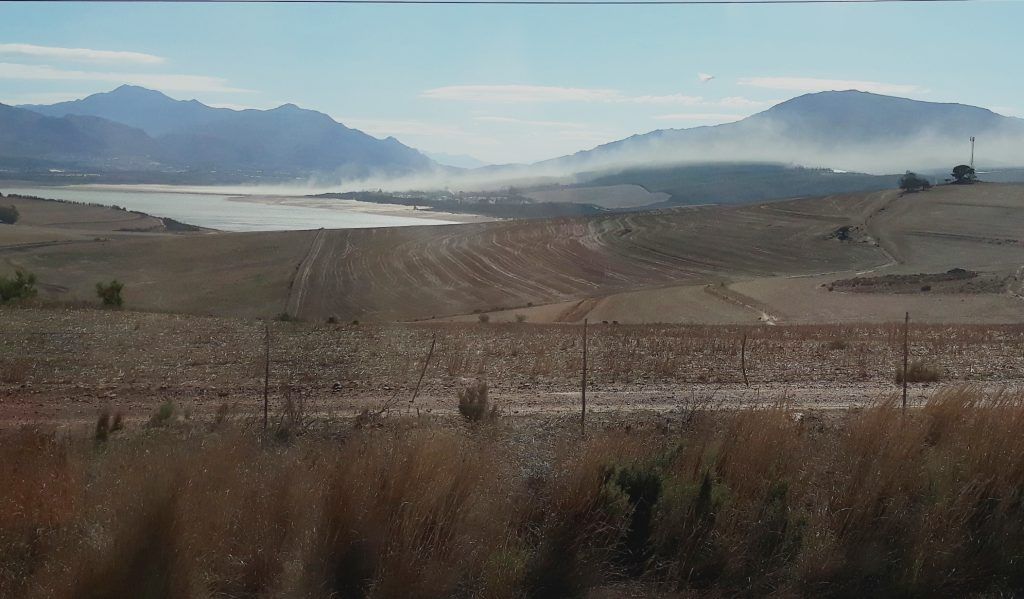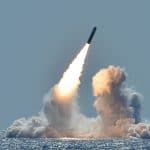What Cape Town learned from its drought
By Piotr Wolski | April 16, 2018
 At the worst of its recent drought, Cape Town’s largest dam—the Theewaterskloof Dam—was 90 percent empty, with dust clouds forming above its shoreline. Image courtesy of Rodger Duffett, University of Cape Town Climate System Analysis Group.
At the worst of its recent drought, Cape Town’s largest dam—the Theewaterskloof Dam—was 90 percent empty, with dust clouds forming above its shoreline. Image courtesy of Rodger Duffett, University of Cape Town Climate System Analysis Group.
Cape Town, the iconic city on the tip of Africa, has recently added a new term to the English vocabulary—Day Zero, or the day when all the taps run dry. For a couple of months in late 2017 and early 2018, this term was the topic of almost every conversation among the city’s approximately 4 million residents, as well as the subject of a multitude of news articles, interviews, opinion pieces, editorials, blogs, and tweets—not just in South Africa, but all around the world.
The term Day Zero refers to a situation where the city’s water reserves reach such a low level that the continuation of what is considered to be a “normal” supply to all users is no longer possible, and the whole system is shut down. Instead, water would have had to be provided through a number of distribution points, with individuals restricted to collecting a daily ration of perhaps only 25 liters (just over six-and-a-half gallons) of the precious liquid. As of the time of writing (April 2018), Day Zero has been largely staved off, but it still remains a possibility, depending on the coming season’s rainfall and the water-saving behavior of the city’s residents. (To give an idea of how close a shave it’s been, as of April 16, measurements taken at the city’s largest reservoir—the Theewaterskloof Dam—show it at only 10.4 percent of capacity. A photo taken by a colleague last Wednesday shows a dust cloud lifted by wind over the dry part of this reservoir, with just a little water visible in the deepest section.)
How did Day Zero come about? How is it possible that a large modern city—a vital economic, tourism, and cultural hub of South Africa, that has been likened to Africa’s version of San Francisco—was about to run out of water? Particularly when outside observers have noted that South Africa has a strong record for addressing previously unmet needs for water and sanitation?And is Cape Town still threatened by the prospect of running out?
First, there was drought. Cape Town’s climate, although not strictly arid, is strongly seasonal, with about 70 percent of its rain falling in just the few months of May to October. The amount of rainfall varies from about 400 millimeters per year (mm/year) in the coastal plains to about 2,000 mm/year in the mountains flanking the region. (For those of us not used to working in metric, these figures refer to about 15.75 inches and 78.74 inches, respectively. To give a sense of scale, downtown Los Angeles gets an average of about 14.93 inches of rain annually, according to the LA Almanac.) Meanwhile, Seattle—notoriously one of the wetter places in the continental United States—receives about 37.49 inches of rainfall per year, or less than half the average amount of rain that falls every year in the Hottentots-Holland mountains, just to the east of Cape Town.)
Drought, usually manifested as rainfall that is considerably lower than average, is a natural phenomenon in any climate, and the current Cape Town drought started in 2015, lasted through 2017 and may extend even longer—so Cape Town is looking eagerly to what the rest of the year 2018 will bring. Since 2015, total rainfall was about 50-to-75 percent of the long-term average, with the 2017 total at many locations being the lowest since the first written records were made in the late 1880s. This three-year drought is estimated to be an event that occurs as rarely as once-in-311 years, but possibly even less frequently.
Other climatic factors such as air temperature also went outside the norm, but to a much lesser degree. Taken together, such conditions are unprecedented in Cape Town’s climate, although droughts of slightly lower severity have occurred in the past, notably in the 1920s, 1970s, as well as the early 2000s.
When Cape Town’s water supply system met the drought. Any drought, particularly meteorological drought, does not necessarily have to translate into a water shortage and water crisis.
But this event did.
Why?
For that, one needs to understand Cape Town’s water supply system, which is based almost exclusively on surface water reservoirs. There are 14 of them, with the so-called “Big Six” storing 99 percent of the water. All of them are located in, or collect water from, mountain catchments where the rainfall is highest. Their combined total storage volume is about one billion cubic meters of water, which is enough to satisfy typical demand for approximately 1.5 years. The typical demand during the hot and dry summer months between November and May—since we’re in the Southern Hemisphere, the seasons are reversed—is equivalent to 35-to-40 percent of the available storage volume. The city of Cape Town accounts for only about 58 percent of that water demand upon the system, with the remaining 42 percent consumed by several small satellite municipalities (approximately 6 percent), regional agriculture (26 percent), as well as the obvious evil—evaporation (roughly 10 percent). (And incidentally, 70 percent of Cape Town’s share is used for residential purposes. The rest goes to municipal and industrial use).
The system operates at a 98-percent level of supply assurance, which translates into an unrestricted supply during 49 out of 50 years. Obviously, that once-in-311 years drought event spelled problems.
The plot thickened. At the end of the rains in 2014, Cape Town’s reservoirs were at 100 percent of capacity; at the end of 2015 they were at 75 percent; and by the end of 2016 they were at 62 percent. This did not cause any immediate problems, because there was still enough water to last until the next rains in May of 2017. However, the authorities soon realized that if the 2017 rainy season was low, there wouldn’t be enough water to last through to 2018. As a result, the first water restrictions were soon introduced, such as limiting outdoor cleaning with a hose, gardening, car washing, and so forth.
Prior to the onset of 2017 rains, South African climate scientists attempted to assess that season’s outlook. Unfortunately, due to the nature of the region’s climate, a reliable forecast could not be formulated—none of the common, model-based forecasting systems exhibit good forecasting skill in the region, and no consensus of opinion could be reached among experts. The advice to the authorities was to prepare for the worst. And by August 2017, the worst had materialized: the driest year on record, with very little chance for improvement during the last months of the rainy season. At that time, the reservoirs were only 37 percent full, and realistically only 27 percent was truly available (the last 10 percent of reservoir storage is almost impossible to access). There was not enough to last until the next rains.
The rest is history. In September 2017, the City of Cape Town came up with an ambitious, although unrealistic, plan to provide additional sources of water (mostly from desalination and groundwater) to the level of 500 megaliters (132 million gallons) per day by June 2018. That was equivalent to expanding the current system’s capacity by 50 percent within less than a year. The plan was accompanied by a very confident assurance that there would be no water rationing before the next rains.
But soon, reality struck. It was going to be harder to get those additional sources of water at the scale and in the time envisioned. It was apparent it was going to be almost impossible to avoid running out of water, for three reasons: relatively few alternative water sources exist in the region that could be mobilized during the dry season; eight months was a very short time to implement any engineering solution; and the specific social and political situation in Cape Town and South Africa imposed significant limitations on the process.
In the Cape Town region, most of the streams and rivers flow only during rainy season, and consequently the use of surface water was out of the question. Two potential groundwater aquifers were known to exist—the so-called Cape Flats shallow sands located within the city itself, and the deep, fractured aquifer of the Table Mountain group located in the nearby flanking mountains. These aquifers, however, were not developed for exploitation previously, and very rapid prospecting was needed. As for alternative sources, the technologies for water reuse and desalination exist, of course, but their implementation at scale would be a major engineering and financial challenge considering the short time frame.
The process of rapid mobilization of any additional water source, and in fact of tackling the crisis situation in general, has proven difficult, not just because of “normal” bureaucratic inertia, but also because there are tensions between the provincial and the national governments, which are in the hands of opposing political parties. These tensions were heightened by the fact that under the South Africa policy system, the role of the national government is to be a financier and developer of large water management infrastructure, while the local and provincial governments are only responsible for the day-to-day management of water resources and the running of water supply networks. National government, too, holds the disaster relief funding. As if that were not enough, South Africa and the governing party has recently been marred by corruption, which was heavily criticized by opposition parties, which themselves suffered from corruption scandals.
All this has lead to a lot of pointing fingers and buck-passing, an inability to take executive decisions, and in general little progress in mobilizing additional water resources. After a few months, the June 2018 augmentation target was scaled down from 500 to 150 megaliters (from 132 to 39 million gallons) per day, and the idea of Day Zero first came up. It was clear that the only way to avoid Day Zero was through water demand management, or coercing users to use less water. In that, Day Zero was a very evocative way of visualizing the emergency. But it was not just a public relations exercise. It was a very, very real possibility.
As early as September 2017, the City of Cape Town introduced stringent water use restrictions: 87 liters (23 gallons) per person per day. (To put this water consumption figure in perspective, the US Geological Survey estimates that the average American uses between 80 and 100 gallons of water per day.) The restrictions were voluntary, because the city had no way of enforcing them at scale. Some controversial solutions were introduced, such as “Water Management Devices” (a euphemism for remote-controlled shut off valves), which were installed in particularly water-wasteful households. And to highlight the direness of the problem, the city mayor personally visited consumers of excessive amounts of water. The restrictions were successful, with water use dropping by 25 percent compared to earlier years, but not successful enough. Towards the end of 2017, only 33 percent of users were below the targeted 87 liters per person per day, and the first quantitative estimates as to the date of Day Zero put it at the beginning of April 2018.
Part of the problem with reducing water use might have been that the authorities communicated with a rather heavy-handed, top-down attitude. Additionally, perhaps due to political pressure, there was little transparency in the decision-making process, and the realism of proposed solutions was sometimes questionable. This led not just to a limited response to water restrictions, but also to intense public debate—focused, unfortunately, on laying blame. In that debate, as usual in such cases, facts were few, opinions plenty. It was the poor versus the rich, which in the South African reality still spans the racial divide. It was the people versus the government. It was the party in opposition versus the party in power.
It was not pretty.
In the meantime, city inhabitants worked themselves into a frenzy, trying to find a way out, independent of the authorities. Borehole drilling companies were in high demand. Rain water tanks tripled in price and there was a 1-to-2 month waiting time, if one was willing to pay in full up front. The plumbers who installed them were the most desired professionals. Buckets and any large water containers disappeared from shops completely. Queues at several natural springs in town required a few hours’ waiting time before one could fill up a container. Supermarkets were informing clients that “Should bottled water be available, it will be sold at no more than 5 bottles per person.” Social media sites were full of advice on how to run a household on 87 liters per day. Journalists were coming up with stories of disease outbreaks and social unrest awaiting after Day Zero. The army was preparing to secure planned water distribution points. And everyone was waiting for the weekly update from the Cape Town water managers: When will there be no more water in the taps? April 5? April 17? Back to April 7 again? Some time in May?
The situation was not really improving, and in February 2018, water restrictions were further tightened to 50 liters (13 gallons) per person per day, with punitive charges for households using more than 6,000 liters per month.
Where is Cape Town now? As of the time of this writing, Day Zero is no longer considered likely to happen in 2018, for several reasons. First, the water restrictions worked, due to a combination of genuine societal will to save water, an increase in tariffs, and water pressure management. Water use dropped to about 520 megaliters (137 million gallons) per day—less than 50 percent of pre-drought levels. Second, the region’s agriculture came into play, with a similar level of demand reduction. Third, the city of Cape Town managed to borrow water from agricultural users in neighboring water catchment areas. And just as importantly, the several water augmentation schemes for tapping groundwater and utilizing desalination plants are to come online in June and July. The situation is much calmer than a couple of months ago. There is bottled water in supermarkets, and the queues at springs are much shorter than before.
Analysts will continue to dissect the crisis in the months and years to come. There already is a multitude, and there will be more of “Someone should have…”, “Had that been done…”, “What if…“ opinions. But opinions are dependent on the particular worldview, political affiliation, and (narrow) professional experience of the observer. Some facts are indisputable, however. The drought was—and still is—very severe, and beyond our control. Our water supply system was not resilient enough to withstand it. In such a situation, other factors likely played only a moderating role.
Let’s consider population growth and related water demand, for example. Cape Town was very successful in reducing water losses in response to the drought of 2000-to-2003, with resulting decoupling of the relationship between population growth and water demand since then. There has been minimal increase in the demand for water in the last 18 years. In fact, the 2016 demand was lower than the lowest demand projection considered, and far below what the system was actually designed to handle, when the expansion of the system was planned in 2007. These facts do not support the thesis that the crisis was caused by increasing demand, which is often brought up in various media.
A big question remains, however: Why wasn’t the water supply system resilient? Surely, in the age of anthropogenic climate change, one can expect droughts to be a threat, and cities such as Cape Town should be prepared for them. In fact, the Cape Town water supply system was planned to be upgraded to accommodate population growth and climate change, and the last such plan was developed in 2007. That upgrade was only slightly behind schedule: One of the planned reservoirs was commissioned in 2009 instead of the original 2007, and the development of substantial new water sources that were to be included in 2017 and 2019 was delayed too. It is possible that lower-than-anticipated demand might have created a false sense of security, and contributed to delays with implementation of system upgrade. It remains to be shown, however, whether the system, if expanded as planned, would manage to go through the drought unscathed.
What is the role of climate change? There has been a moderate (around 20 percent) decline in rainfall in some areas around Cape Town over the last 40 years, but that appears to be related to the usual variability that occurs over the span of decades and which likely underlies previous droughts of similar magnitude, namely those occurring in 1920s and 1970s. Long-term rainfall trends are weak and vary from place to place throughout the region, with some locations getting wetter and some getting drier in the last 100 years. The link between these mid-term and long-term trends and anthropogenic climate change is not clear at the moment. It is clear, however, that the effect of these trends—and as a result, potentially climate change—is merely to modify the drought’s magnitude rather than be a direct cause. Projections of future climate suggest that rainfall in the Western Cape in general will either stay the same or gradually decline in the future. With the projected increase in air temperatures, and likely evaporation, the water balance will not be favorable for water resources. The current drought is consequently likely to be a harbinger of the things to come, although it is not likely “it” yet.
Cape Town went through a process of learning and adaptation to conditions that are likely to occur more often in the future—conditions also faced by many cities in the world. The city has not only staved off the immediate threat, but hopefully emerged more resilient. There are many developments that are here to stay: a transformed, more resilient water supply system; water-saving hardware in houses; water-saving behaviors—or at least a good knowledge of such; a growing comprehension of water as a limited resource; a greater understanding of the workings of the water supply system; various community initiatives to support water-saving in general; providing support to the vulnerable; experience of government structures in working with incipient crisis; and so forth.
The list goes on and on. This all bodes well for the city to face the challenges of the future. Learning was a hard process.
But the outcomes were worth it.
Together, we make the world safer.
The Bulletin elevates expert voices above the noise. But as an independent nonprofit organization, our operations depend on the support of readers like you. Help us continue to deliver quality journalism that holds leaders accountable. Your support of our work at any level is important. In return, we promise our coverage will be understandable, influential, vigilant, solution-oriented, and fair-minded. Together we can make a difference.
Topics: Analysis














